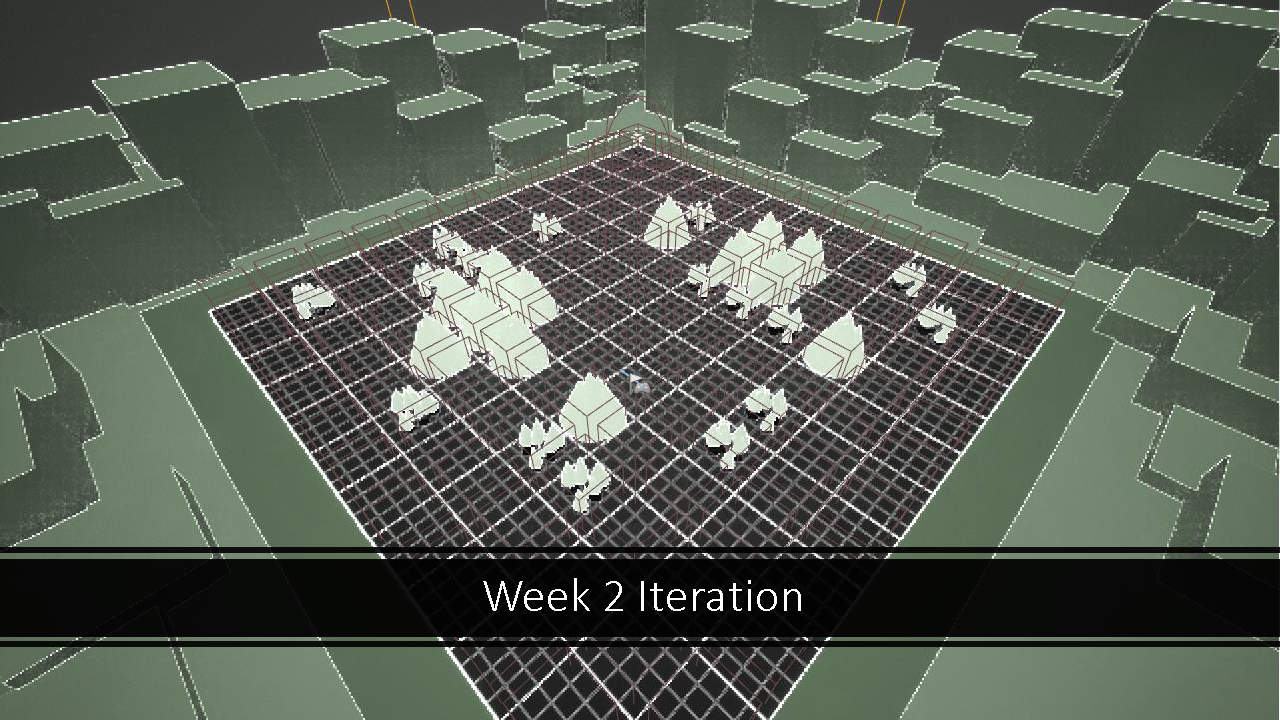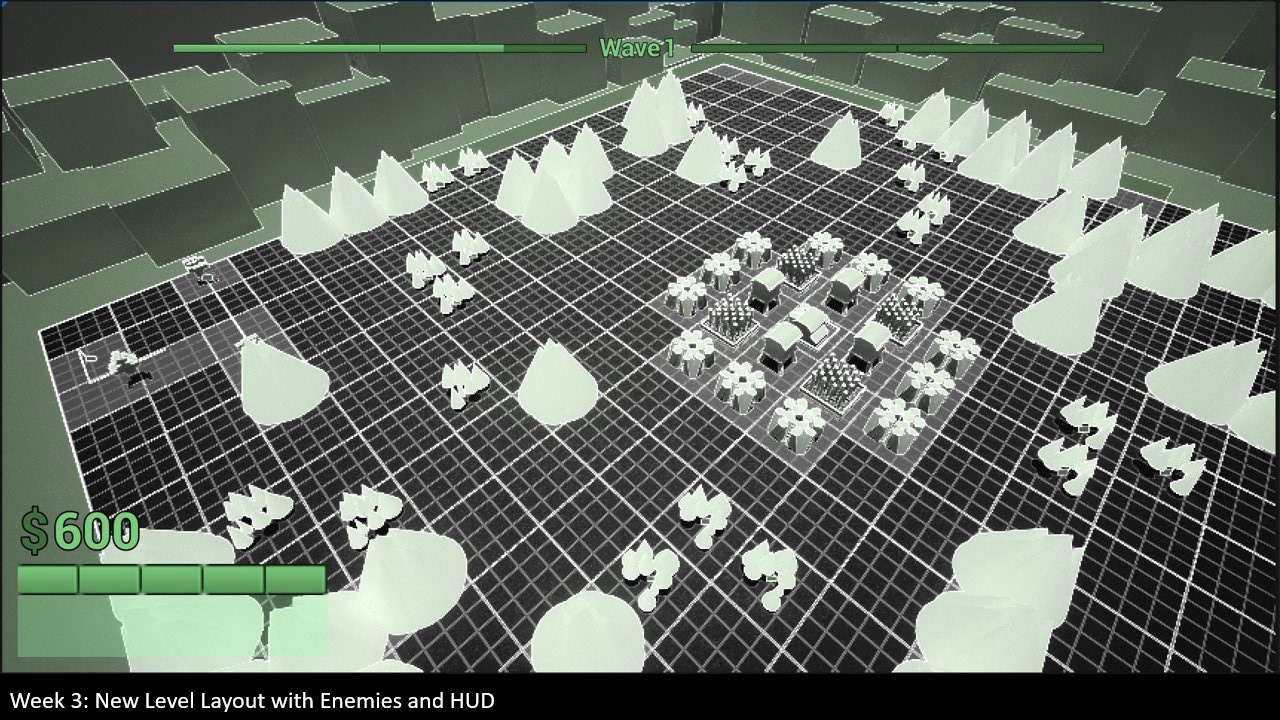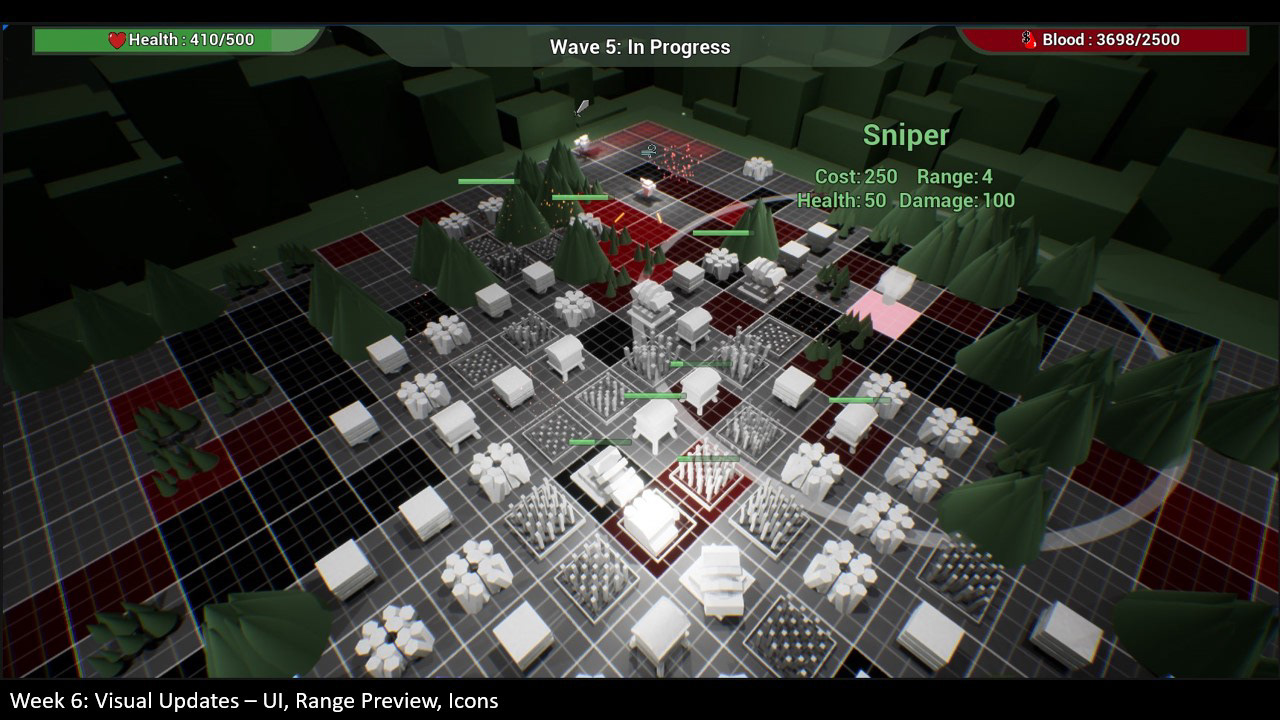Where It Started
Homestead is an entry into a genre with Resource Management baked into its very DNA. What to spend, when to spend it, and what to spend it on are questions players of the tower defense genre ask each time they make a decision. Thus, as a designer, I had these questions to answer: What resources will my players have? What will they be spending them on? Why will they be spending those resources?
When pitching this project, these are questions I had barely considered. Version 1 of Homestead, as presented, was as bland and basic as a tower defense game could get.




Feature Farming
Lucky for me, feedback to my initial pitch produced the idea of Farming. In my eyes, Farming and tower defense are a match made in heaven. A genre centered around development and strategic cultivation meets ACTUAL cultivation? It just makes sense!
Images shelves stocked with various plants labeled MEANINGFUL CHOICE floated through my mind.
My milquetoast tower defense game had hope! All that was missing was a coherent design.
Updated Mood Board



Blood for the Blood God
As development went underway and I began to program Homestead's core mechanics, I also continued to iterate upon the design.
Core Player Actions:
Buying Towers, Growing Crops, and Making Profits
Core Mechanics:
Waves of Enemies, Automated Defenses, and Blood-Agriculture Economy
Buying Towers, Growing Crops, and Making Profits
Core Mechanics:
Waves of Enemies, Automated Defenses, and Blood-Agriculture Economy
Written at the bottom of my Week 2 process book slides was the quote: "Water your crops with the blood of your enemies"





Going the Wrong Way
At this point, the project was progressing smoothly. I was hitting my deadlines, refining the visuals, and implementing my most critical features. Unfortunately, I had forgotten that little line about Blood that was supposed to be my guiding Aesthetic.
I was totally lacking in Medium Term Goals. There was nothing for players to think about or strive towards when they weren't fighting off immediate defeat.
To try and course correct, I came up with a series of possible solutions. Unfortunately, the solutions I came up with managed to both ignore the core aesthetic and add unnecessary fluff.
After a few sessions of playtesting, I was able to realize that Homestead was primarily suffering from the absence of my core aesthetic. This realization took me back to the drawing board.



Pump it Up; Recognizing the Problems
Problems:
1. Blood Aesthetic is Lacking
2. Decisions are Arbitrary/Non-Strategic.
1. Blood Aesthetic is Lacking
2. Decisions are Arbitrary/Non-Strategic.
Solution 1: Pumps and Pipes
- Blood pools in ground
- Blood is extracted by pumps
- Issue: What purpose do crops serve?
- Blood pools in ground
- Blood is extracted by pumps
- Issue: What purpose do crops serve?
Solution 2: Blood as Fuel
- All Towers and Crops* must be placed on Bloody Tiles
- Power and Efficiency are Boosted Accordingly
- Issue: Properly "Herding" enemies is hard/lost
- All Towers and Crops* must be placed on Bloody Tiles
- Power and Efficiency are Boosted Accordingly
- Issue: Properly "Herding" enemies is hard/lost
Solution 3: Enemy Types
- Some enemies are resistant to certain towers
- Some enemies are resistant to certain towers
In this Economy? Addressing the Problems
Final Decision:
- Scrap Crop Variety
- Blood Pump Tower No Pipes
- Blood Sprinklers to Enhance Crops
- Blood Injectors to fight Blood-Lusted Champions
- Scrap Crop Variety
- Blood Pump Tower No Pipes
- Blood Sprinklers to Enhance Crops
- Blood Injectors to fight Blood-Lusted Champions
It all started to come together while I was brainstorming for answers to the problems I'd identified. Suddenly, I recognized the Resource Economy.
Blood => Money; Money => Damage; Damage => Blood
The solution to my problems lay in forging those connections.
Blood => Money; Money => Damage; Damage => Blood
The solution to my problems lay in forging those connections.
Within the new framework, Players would constantly be working towards something - be that greater blood revenue, greater money generation, or stronger defenses.
Aesthetic Goals
At long last, Homestead fulfilled its promise of "Watering your crops with the blood of your enemies."
I had seen the matrix. Players didn't just have to defend against droves of enemies, they had to actively manage their resources. They had to learn to juggle Blood and Money, splitting their time between developing necessary defenses and cultivating resource generation. It was beautiful!
Only... It was too easy.
Slides from my Final Pitch Deck





In Retrospect
The final deadline for Homestead came too quickly and I was soon whisked away onto other projects and the enormous experience that was GDC 2023.
As I re-examine Homestead a month and a half out from my final edit, I can now recognize that my Resource-Revelation came far too late to be properly balanced.
An additional discovery has helped me better understand why, however.
This Article by Yvens Serpa helped me see what I had been missing.
This Article by Yvens Serpa helped me see what I had been missing.
Quoting the 2004 book Fundamentals of Game Design by Ernest Adams, Serpa explains the Pillars of what is called an Internal Economy.
These pillars are Sources, Drains, Converters, and Traders.
Sources generate resources, Drains remove them, Converters remove one resource in exchange for generating another, and Traders swap the ownership of resources without adding or removing any in addition.
Production Rates, Destruction Rates, and Conversion Rates can be Upgraded or Downgraded for each of these and resource equilibrium can be reached on either a Global or Player scale.
In coming to understand these concepts, I can now recognize a path towards game balance where I didn't before.
In Homestead (or in any game I make with an Internal Economy) I can categorize my Sources, Drains, Converters, and Traders and quantify their Production, Destruction, and Conversion Rates.
For example, an enemy in Homestead would have a production rate of X amount of Blood and a destruction rate of X amount of Damage equating to Health.
From there I can determine the approximate amount of each resource I want available to the player at any stage in the game. Homestead is conveniently divided into 10 waves. For wave 1, I would want my players to have an Abundance of options and alongside an Abundance of Resources. By wave 5, however, I may want an Abundance of options but a Shortage of Resources.
I can facilitate and monitor the exact quantities of these things by determining the ideal disparity between resources and options and calculating how much of each resource to provide.
Essentially, I have been given the tools to adjust difficulty to my exact specifications so as to better place players into the Flow State.
In Conclusion
Homestead pushed me as a programmer and as a designer with all the complex design challenges that accompany the development of resource-centric games. In the process of confronting these challenges I learned a lot about effective systems design, readability, and the creation internal economies. Beyond these lessons, I also learned an important lesson in aesthetic-adherence. If I were to continue development on Homestead, I would do so with greater confidence in my ability to create an enjoyable experience.
Homestead has given me a powerful tool for gauging the success of any system, encounter, level, or game that I design.
"How well does it fulfil, engage, or invoke the aesthetic?"
I'm happy to say that Homestead fulfils its aesthetic.
Homestead is a game where you can water your crops with the blood of your enemies.